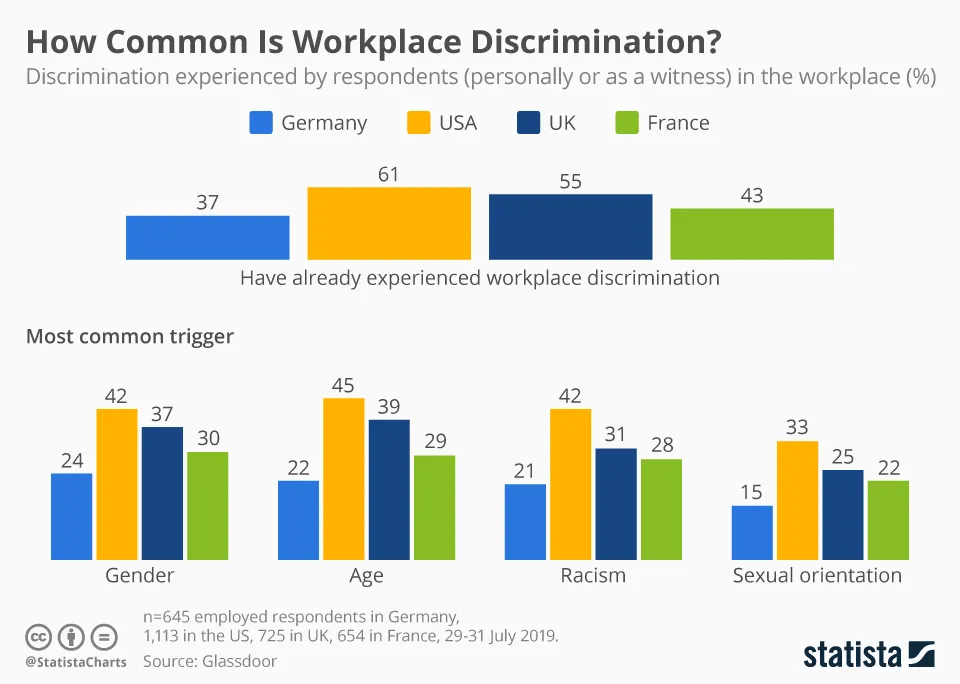A Hard Look in the Mirror: Why the U.S. Leads in Workplace Discrimination

In my decades of work as a civil rights advocate, I’ve seen both tremendous progress and disheartening stagnation. We hold up the American ideal of the meritocracy—a place where anyone can succeed through hard work and talent, regardless of their background. Yet, for millions, the reality of their daily work life tells a very different story. The unfortunate truth is that workplace discrimination in the United States remains one of the most persistent barriers to true equality.
A sobering 2019 study, visualized in an infographic from Statista using Glassdoor data, lays this reality bare. It compares the experiences of workers in four major Western economies: the United States, the UK, Germany, and France. The findings are a stark wake-up call. When asked if they had personally experienced or witnessed workplace discrimination, a staggering 61% of U.S. respondents said yes.
This figure is alarming on its own, but it becomes even more troubling when compared to the other nations surveyed. The U.S. significantly outpaces the UK (55%), France (43%), and Germany (37%). This data forces us to ask an uncomfortable question: Why does the nation that prides itself on being a “land of opportunity” have the highest rate of perceived workplace discrimination among these peers?
The Four Faces of Workplace Discrimination in the United States
The report goes beyond the top-line number, breaking down the most common triggers for discrimination. In every single category, from age and gender to racism and sexual orientation, the United States leads. This isn’t an anomaly in one area; it’s a systemic pattern that demands our attention.

1. Ageism: The Most Common Offense
According to the data, the most common trigger for discrimination in the U.S. is age. A shocking 45% of American respondents reported experiencing or witnessing age-based discrimination. This is significantly higher than the UK (39%), France (29%), and Germany (22%). This form of prejudice, often aimed at older workers, is fueled by false stereotypes about productivity, adaptability, and technology. In a culture obsessed with youth and “disruption,” experienced professionals are too often pushed aside, denied promotions, or edged out of their jobs. Despite protections from the Age Discrimination in Employment Act (ADEA), ageism remains a pervasive and deeply ingrained problem.
2. Racism and Gender: The Enduring Twin Pillars of Prejudice
Tied for the second-most-common trigger in the U.S. are racism and gender discrimination, with 42% of respondents reporting each.
The figure for racism (42%) is a painful reminder of the deep-seated racial inequality that continues to plague our nation. It’s far higher than the UK (31%), France (28%), and Germany (21%). This discrimination manifests in countless ways: biased hiring practices, significant pay gaps for people of color, a lack of representation in leadership, and the daily burden of microaggressions. These are not isolated incidents; they are symptoms of systemic issues that federal laws like Title VII of the Civil Rights Act of 1964 are designed to combat, yet the fight is clearly far from over.
Similarly, gender discrimination at 42% shows that the battle for equality in the workplace is an ongoing struggle. This number towers over France (30%) and Germany (24%). Women, and particularly women of color, continue to face obstacles like the persistent gender pay gap, the “glass ceiling” that limits advancement, and pregnancy discrimination. The #MeToo movement cast a harsh light on harassment, but this data shows that the broader culture of gender bias remains deeply entrenched.
3. Sexual Orientation: Progress Marches On, But Bias Remains
Finally, the study highlights discrimination based on sexual orientation. While the 33% figure in the U.S. is lower than the other triggers, it is still substantially higher than in the UK (25%), France (22%), and Germany (15%). This demonstrates that LGBTQ+ individuals continue to face significant prejudice at work. Landmark legal victories, such as the Supreme Court’s 2020 ruling in Bostock v. Clayton County which affirmed that Title VII protects against discrimination based on sexual orientation and gender identity, are crucial. However, laws alone do not erase bias. Creating a genuinely inclusive environment where all employees feel safe and respected is a cultural challenge that this data proves we have yet to overcome.
Why Is This Happening? A Call for Deeper Reflection
The data shows what is happening, but as a civil rights expert, I am compelled to explore the why. There is no single answer, but several factors likely contribute to the high rates of workplace discrimination in the United States.
Our “at-will” employment culture, which exists in most states, allows employers to terminate an employee for almost any reason, as long as it isn’t an illegal one (like discrimination). This can create a climate of fear and make it harder for employees to challenge unfair treatment compared to the stronger, union-backed worker protections common in many European countries.
Furthermore, while our awareness of discrimination may be higher, a factor that could lead to more reporting, the sheer size of the gap between the U.S. and other nations suggests a difference in reality, not just perception. The intense, high-pressure nature of American work culture can also foster toxic competition and “in-group/out-group” dynamics that provide fertile ground for bias to grow.
The Path Forward: A Responsibility for All
These statistics are not just numbers on a chart; they represent millions of careers stunted, passions diminished, and lives made more difficult. But they do not have to be our destiny. This data should serve as a catalyst for action.
For employers, this is a call to move beyond performative diversity initiatives. It’s time to invest in meaningful change: conduct pay equity audits, implement blind resume reviews to reduce bias in hiring, provide robust and continuous training, and, most importantly, create transparent and safe channels for reporting and addressing discrimination without fear of retaliation.
For employees, know your rights. Familiarize yourself with the protections offered by the Equal Employment Opportunity Commission (EEOC) and your state’s civil rights agencies. Document any instances of discrimination and don’t be afraid to seek support and legal counsel.
As a society, we must commit to building workplaces that live up to our nation’s promise. The first step is acknowledging the uncomfortable truth that this data presents. The U.S. has a serious workplace discrimination problem. Only by looking in the mirror, as difficult as it may be, can we begin the hard work of creating a more just and equitable future for all American workers.
Stay Updated
Get the latest updates about workplace rights and our app launch.